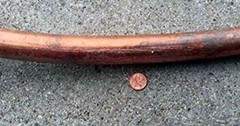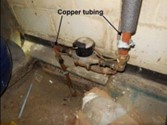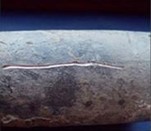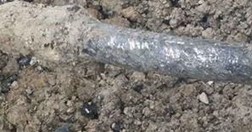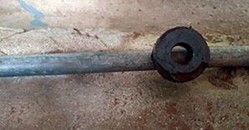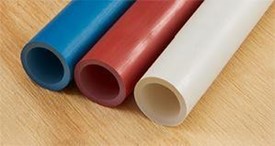Lead Service Line Study Announcement
Congress banned use of lead water pipes in 1986. On December 16, 2021, the Federal Lead and Copper Rule Revisions (LCRR) that went into effect requires every federally defined community and non-transient, non-community water system to develop a service line inventory. By 2024, all water utilities are required to determine where lead water pipes may exist in their systems, including the pipes on the customer side that connect to the public system.
In March 2024, the Village of New Paltz received a grant award of $193,125 from the NYS Department of Health (DOH) using funding through the Drinking Water State Revolving Fund (DWSRF). The funds provide engineering and technical assistance for lead service line identification, including inventory planning, records review, and public outreach.
Fortunately, we have not found significant instances of lead piping within New Paltz’s water system and there have been no reports of lead in our municipal drinking water. There are some small sections within the conveyance system that are used for connecting pipes (on N. Chestnut St, for example) that contain lead which are being removed. The plan is to remove all such lead piping as required. This is why we are asking for your participation in the process.
Upon completion of our study, a plan will be created for removal of any additional lead pipe lines, which may be identified.
In addition to gathering our municipality’s records, we are requesting that ratepayers of New Paltz’s Municipal Water System respond to the survey linked below:
Please contact the Village with any questions. Thank you.
Lead is rarely found naturally in our source water or in the treated water flowing through the distribution system. More commonly, lead leaches into water over time through corrosion – a dissolving or wearing away of metal caused by a chemical reaction between water and you’re plumbing. Lead can leach into water from pipes, solder, fixtures, faucets (brass) and fittings. The amount of lead in your water depends on the types and amounts of minerals in the water, how long the water stays in the pipes, the water’s corrosivity, and water temperature.
Health Effects of Lead
Exposure to lead in drinking water can cause serious health effects in all age groups. Infants and children can have decreases in IQ and attention span. Lead exposure can lead to new learning and behavior problems or exacerbate existing learning and behavior problems. The children of women who are exposed to lead before or during pregnancy can have increased risk of these adverse health effects. Adults can have increased risks of heart disease, high blood pressure, kidney or nervous system problems.
Sources of Lead
Lead is a common metal found in the environment. Drinking water is one possible source of lead exposure. The primary source of lead exposure for most children is lead-based paint. Other sources of lead exposure include lead-contaminated dust or soil, and some plumbing materials. In addition, lead can be found in a number of consumer products, including certain types of pottery, pewter, brass fixtures, food, and cosmetics. Other sources include exposure in the workplace (jobs that include house painting, plumbing, renovation, construction, auto repair, welding, electronics repair, jewelry or pottery repair) and exposure from certain hobbies (such as stained glass or pottery, fishing, making or shooting firearms and collecting lead or pewter figurines), as lead can be carried on clothing and shoes. Children’s hands or their toys can come into contact with lead in paint, dust, and soil. Therefore, washing children’s hands and their toys will help reduce the potential for lead exposure from these sources.
Plumbing materials, including pipes, new brass faucets, fittings, and valves, including those advertised as “lead-free,” may contribute lead to drinking water. The law currently allows pipes, fittings, and fixtures with up to 0.25 percent weighted average of lead to be identified as “lead-free.”
The Village of New Paltz does not have any lead in its source water or water mains in the street. When water is in contact with pipes [or service lines] or plumbing that contains lead for several hours, the lead may enter drinking water. Homes built before 1986 are more likely to have plumbing containing lead. New homes may also have lead; even “lead-free” plumbing may contain some lead.
Steps You Can Take to Reduce Your Exposure to Lead in Your Water
-
Run your water to flush out lead. Before drinking, flush your home’s pipes for several minutes by running the tap, taking a shower, doing laundry, or doing a load of dishes. The amount of time to run the water will depend on whether your home has a lead service line or not, and the length of the lead service line. Residents should contact their water utility for recommendations about flushing times in their community.
-
Use cold water for cooking and preparing baby formula. Do not cook with or drink water from the hot water tap; lead dissolves more easily in hot water. Do not use water from the hot water tap to make baby formula.
-
Do not boil water to remove lead. Boiling water will not reduce lead.
-
Replace your plumbing fixtures if they are found to contain lead. Plumbing materials including brass faucets, fittings, and valves, including those advertised as “lead-free,” may contribute lead to drinking water. The law previously allowed end-use brass fixtures, such as faucets, with up to 8 percent lead to be labeled as “lead-free.” As of January 4, 2014, end-use brass fixtures, such as faucets, fittings, and valves, must meet the new “lead-free” definition of having no more than 0.25 percent lead on a weighted average. Visit the NSF website at http://www.nsf.org/newsroom_pdf/Lead_free_certification_marks.pdf to learn more about lead-containing plumbing fixtures and how to identify lead-free certification marks on new fixtures.
-
Use bottled water or use a water filter. If your home is served by a lead service line, or if lead-containing plumbing materials are found to be in your home, you may consider purchasing bottled water or a water filter. Read the package to be sure the filter is approved to reduce lead or contact NSF at 1-800-NSF-8010 (1-800-673-8010) or visit https://info.nsf.org/Certified/dwtu/listings_leadreduction.asp, for a consumer guide of approved water filters. In conjunction with flushing, properly operated filters are highly effective at reducing lead exposure. Be sure to maintain and replace a filter device in accordance with the manufacturer’s instructions to protect water quality. Any measure you take to reduce your exposure to lead should be continued until the lead source(s) has been minimized or eliminated.
Should you test your water for lead?
If lead-containing plumbing materials are identified in your home, you may want to consider testing your water for lead to determine how much lead is in your drinking water. Call us at [insert phone number for your water system] to find out how to get your water tested for lead. [Include information on your water system’s testing program. For example, do you provide free testing? Are there labs in your area that are certified to do lead in water testing?]
Should your child be tested for lead?
New York Public Health Law requires primary health care providers to screen each child for blood lead levels at one and two years of age as part of routine well-child care. In addition, at each routine well-child visit, or at least annually if a child has not had routine well-child visits, primary health care providers assess each child who is at least six months of age, but under six years of age, for high lead exposure. Each child found to be at risk for high lead exposure is screened or referred for lead screening.
If your child has not had routine well-child visits (since the age of one year) and you are concerned about lead exposure to your child, contact your local health department or healthcare provider to find out how you can get your child tested for lead.
How to Check your Service Line for Lead
Steps to Check Your Service Line
Materials Needed: Key or coin, strong magnet, phone, or tablet (to take picture)
Step 1: Location
- Find the water meter. This can be in a basement, crawl space or other exterior wall. (Reference images below for visual assistance)
- Look for the pipe that comes through the wall of your home and connects to the
Step 2: Test the Pipe
- Use a key or coin to gently scratch the pipe like you would scratch a lottery
- If the pipe is painted, use sandpaper to expose the metal
- Place the magnet on the pipe to see if it sticks to the
Step 3: Conclusion & Submission
- Determine your pipe material based on the scratch test and magnet
- Take a picture of the service line (incoming water service).
- Complete the survey.
Types of Service Line Materials
IF YOUR PIPE IS COPPER: The pipe may appear dull brown on the outside but will be the color of a bright penny if gently scratched. Magnet won’t stick.
IF YOUR PIPE IS LEAD: The pipe will appear dull and soft but will turn a shiny silver color when scratched. Magnet won’t stick.
IF YOUR PIPE IS GALVANIZED STEEL: The scratched area will remain a dull gray. Magnet will stick.
IF YOUR PIPE IS PLASTIC OR PVC: If the service line is blue, white, or black, does not appear to be any of the other materials listed above, and a magnet will not stick to the surface, your service line is most likely plastic.

